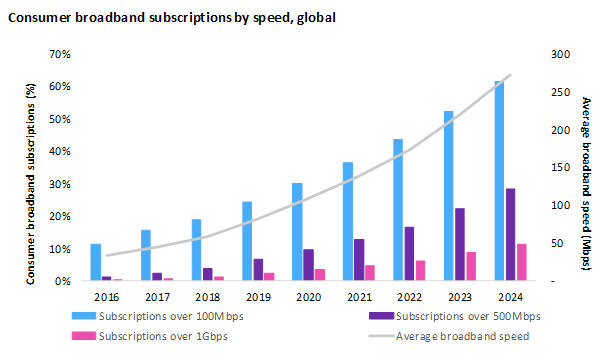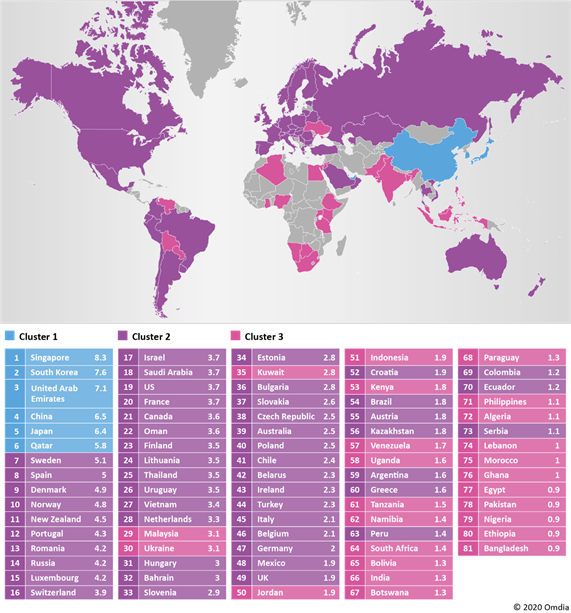Fiber Access and IP/Optical Networks: the Foundations of the Digital World
By Michael Philpott, Research Director, Service Provider Consumer, Omdia
Due to the importance of fiber investment and its impact on global development, Omdia has created a new benchmark known as the Global Fiber Development Index.
A world of applications driving ultrafast broadband
The importance of broadbandBroadband access, whether mobile of fixed, remains a key revenue source for telecommunication service providers. On a global basis, the sum of mobile and fixed broadband, pay-TV, OTT video, digital games and digital music will be worth $1.4bn by 2024. Although a lot of attention is often placed on the smaller segments such as OTT video and digital gaming, likely because of their growth potential, by 2024 mobile and fixed broadband will still account for 62% of the revenues from this market.
The influence and impact of broadband access however goes far beyond direct subscription revenue. Increasingly, it is broadband connectivity that enables innovation and growth in other adjacent industry sectors as businesses rapidly digitize their platforms. Based on research carried out for the European Union, the ICT sector in Europe accounts for approximately 50% of all productivity growth.
If anything, the COVID-19 crisis has only highlighted both consumer and business dependency on broadband connectivity as people move to remote working and education as well as of course digital communications and entertainment. This increased reliance on broadband connectivity has elevated the broadband service provider’s role in both the home and society as a whole.
The move to a gigabit worldThe leading trend in broadband continues to be the push towards ultra-high-speed services with many countries around the world already offering gigabit plus services, and the average broadband speed on a global basis over 250Mbps by the end of 2024 (see Figure 1). Figure 1: The race to gigabit broadband services

Source: Omdia
Skeptics will say that this rapid growth in speed is largely marketing driven. However, there is a genuine need for speed, especially as both consumer and enterprise customers move to advanced, bandwidth hungry applications such as ultra-4K video, and ultra-high definition VR and AR.
Governments also now understand the importance of high-speed broadband networks on driving their economies. There are now numerous studies that show that broadband investment, not just in terms of coverage but also in terms of speed, drives greater economic growth. For example, a study by the ITU suggests that a 10% increase in broadband penetration results in a 0.25 to 1.5% growth in GDP, and a study by the EIB outlines that a further 0.3% growth is possible for every doubling in speed.
A step change in broadband quality demands further fiber investment
A futureproof networkThis increased push for higher speeds requires significant and consistent investment in our broadband networks – and a big element of that is greater investment in optical networks in the core, backhaul and access networks.
Optical fiber is of course not the only broadband technology capable of delivering ultra-high-speed services – cable and FWA technologies for example are both capable of delivering gigabit broadband. However, optical fiber does have several characteristics that make it a truly futureproof technology, the two most important being:
- Limitless and fully symmetrical speeds
- High reliability and relatively low maintenance leading to low operational costs FTTH is a core ingredient to optimum QoE
- a bandwidth or 48Mbps
- latency of less than 20ms
- jitter of less than 7ms.
- Cluster 1: Countries with highly developed both broadband and FTTH penetration.
- Cluster 2: Developed broadband countries that have a high-level of broadband household penetration but relatively low FTTH penetration
- Cluster 3: Emerging broadband countries that have a low-level of broadband household penetration and have a relatively low FTTH penetration. Figure 3 Fiber Development clusters enable more focused recommendations
- Deployment: Providing a more intelligent network that is able to flex around the users’ needs, speeding up time to service, reducing manpower costs and increasing operational efficiency
- Provisioning: creating a more ‘OTT like’ experience by enabling customers to turn new services and applications on and off at the touch of a button. This creates greater customer satisfaction as well as enabling new, easy to manage business models for the service provider.
- Service optimization: automated service optimization ensuring that customers get the best experience 100% of the time, resolving potential service issues even before the customer even notices
- Troubleshooting: remote troubleshooting using data analytics, so that when an issue does occur they can be resolved quickly and efficiently.
- Fiber is essential for future GDP growth. Due to the COVID-19 crisis economic growth across the globe is at its lowest for many years. However, with significantly more people working and being educated from home, broadband access has never been more important. In order to achieve the best chance of bouncing back from the COVID-19 crisis, governments must look to invest in their national broadband networks.
- Fiber connectivity is the most futureproof access technology. Future broadband applications will require a mix of certain network KPIs such as high down and upload speeds, low latency and low jitter, if they are to provide the right level of experience to the end user. Based on network measurement data, an end-to-end fiber optic network is the best performing type of network across all such metrics. Furthermore, it is virtually futureproof, and is more reliable and secure than other forms of network – making it an ideal choice of infrastructure for residential and enterprise customers alike.
- Not all countries are equal. Although the endgame is the same, countries are all at different starting points and face different set of challenges. It is essential that stakeholders recognise these differences and set out ambitious, but highly-relevant, targets and strategies for their individual markets.
- Investment in IP/Optical infrastructure is required to meet needs on end-to-end basis. Networks will continue to expand in terms of scale and complexity. New technology such as IPv6 and AI will be key network investments if the new network challenges and requirements are to be met.
When benchmarking broadband services, the most common key-performance indicator (KPI) monitored is download speed. However, increasingly other network metrics such as upload speed, latency and jitter are becoming equally important to meet consumer experience expectations. As our reliance on broadband networks at home and work intensifies, it will also become important to monitor network and service variance so that reliability requirements are also met.
As a simple example, if we take a typical consumer application such as cloud gaming, for a perfect level of experience Huawei recommends the following:
By only considering headline speed, most broadband technologies other than basic-ADSL would be capable of meeting the minimum of criteria. However, network data provided by testing specialists such as MedUX have proven that FTTH services are the most consistent in meeting all the required criteria when latency and jitter requirements are also taken into account.
The Fiber Development Index
Introducing the fiber development indexDue to the importance of fiber investment and its impact on global development, Omdia has created a new benchmark known as the Global Fiber Development Index. Unlike some other benchmarks that only track a single development metric such as say coverage or household penetration, the Global Fiber Development Index aims to capture all elements of fiber investment, specifically fiber access, mobile fiber backhaul, core fiber backhaul, and then the overall fiber QoS, which is currently measured by overall average download and upload speed.
Only be optimizing each of these separate investment areas can a country maximize the overall end-user broadband experience, whether that is provided via a fixed or mobile access-connection.
Global Fiber Development Index top-level resultsThe Global Fiber Development Index maps fiber investment in over 80 of the world’s leading broadband countries. Singapore leads the 2020 index with an overall score of 8.3 out of 10. South Korea (7.6), United Arab Emirates (7.1), China (6.5), and Japan (6.4) make up the rest of the top 5 countries.
Singapore scored a maximum score (10 out of 10) in Fiber to the Home (FTTH) penetration (99%), Fiber to the cell Site (FTTS) Fiber Penetration (94%), FTTH Population Coverage (100%), and both Download (195Mbps) and Upload speeds (204Mbps). Two areas were Singapore doesn’t lead is in Fiber to the Business (FTTB) penetration (which China leads with 44%) and Fiber Backbone Length (in which area Oman is the leading country). Please also note that two other countries (Oman and South Korea) get maximum scores along with Singapore for FTTH Population coverage.
The first European country in the ranking is Sweden, resting in 7th position with a score of 5.1. Sweden is closely followed by Spain (5.0), Denmark (4.9), and Norway (4.8). The US heads the Americas region with a score of 3.7, positioned 19th in the world overall.
Figure 2: Omdia’s Global Fiber Development Index (FDI) 2020 ranking

Source: Omdia
The creation of country clusters
The Global Fiber Development Index covers 81 territories of varying sizes, demographic and geographical profiles, as well as levels of broadband development. Due to these widely differing characteristics it makes it nonsensical to directly compare all of them with each other, which if done would, in Omdia’s opinion, only lead to unfair and unhelpful conclusions and recommendations.
Therefore, to compare individual results of the Fiber Development Index Omdia created three different country clusters:

Source: Omdia
More than access: the importance of IP/Optical for network infrastructure
The transition to IPv6 is underwayOver the next few years, the number of connected devices and objects is set to rocket – reaching nearly 9bn end connections in industrial IoT and mobile devices alone. However, with IPv4, the world is already running out of usable IP addresses. IPv4 enables 4.3bn IP addresses, but only 2.8bn of these can be used. Of these 2.8bn a third are assigned to large organizations and a further 1bn are used by hackers (and thus in the SPAM house). So approximately, there are 1-1.5Bn useable IP addresses, to connect already more than 5Bn end devices and growing.
Table 1: growth in devices
Source: Omdia
IPv6 solves this problem by basically providing an enormous address space. However, IPv6+ or an enhanced IPv6 represented by protocol innovation such as SRv6, BIER6, and APN6, also combine AI capability which can be used to enable features such as differentiated guaranteed service and higher network resource utilities ratios, as well as swift provision and fast fault location. All key elements for tomorrow’s broadband networks.
Developing the next-generation of broadband networks is of course more than just deploying more optical fiber. To meet future needs we need those networks to be capable of connecting huge numbers of devices, guarantee end-to-end quality, and enable swift service provisioning. For this it is imperative that industry moves to IPv6 and IPv6+. Governments across the globe now recognize the importance of IPv6 and take up is expected to reach significant scale over the next 5 years.
AI-based networks will be critical to future successDuring the COVID-19 crisis, broadband service providers have seen in some cases 2 to 3 times the number of customer service calls. To some extent this is positive for broadband providers as it shows not just a continued interest in broadband services, but a step-increase in them. However, it also provides a dilemma as of course service provides, like all industries, are having to manage their own workforce through the crisis. This includes support staff having to work from home, reduced staffing levels due to self-isolation, and field-engineers having to adopt new working procedures, especially when visiting customer premises. All this adds up to a scenario of increased levels of customer interaction multiplied by rising costs per interaction – especially when home visits are required.
This will not be a short-term phenomenon, as new procedures, as well as consumer weariness, will remain in force for some time. The result will be an acceleration towards ‘zero-touch’ service provisioning using AI-based networks and platforms in four key areas: